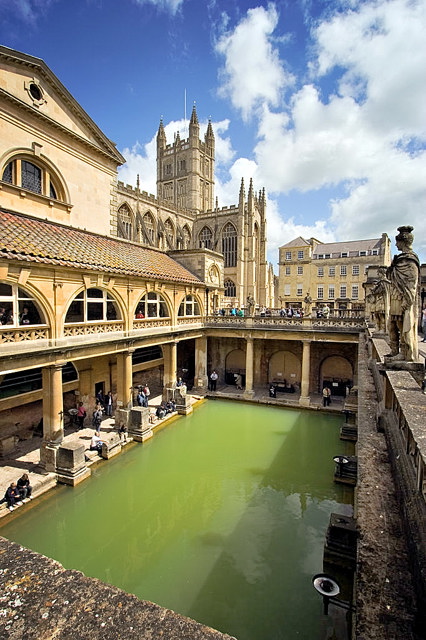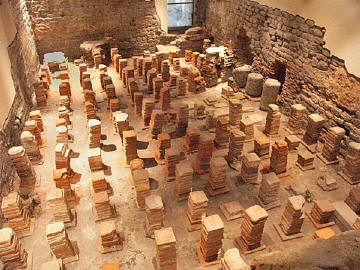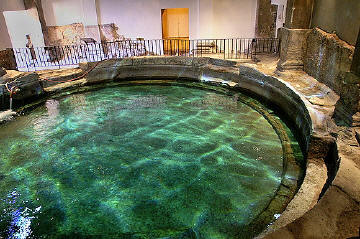Roman Baths
Bath, Somerset
|

Featured Location Guide |
"A part of the World
Heritage Site - City of Bath"
| Bath or Aquae Sulis was a small town in the
Roman province of Britannia and was a religious settlement which was given
defensive stone walls, probably in the 3rd century. The area within the walls
was largely open ground initially but soon began to be filled in. The Romans
were probably in occupation from around 43AD attracted by the natural hot spring
which had been a shrine to the Celtic Brythons and dedicated to their goddess
Sulis. The Spring is a natural mineral spring and the Baths were built up around
it and an adjoining temple was also built. Today they can be viewed in the
centre of the city. The Romans identified with Minerva their
goddess of water, however the name Sulis continued to be used after the Roman
invasion, leading to the town's Roman name of Aquae Sulis (literally, "the
waters of Sulis"). The adjoining temple was constructed in 60-70 AD and the
bathing complex was gradually built up over the next 300 years. During the Roman
occupation of Britain, engineers drove oak piles to provide a stable foundation
into the mud and surrounded the spring with an irregular stone chamber lined
with lead. In the 2nd century it was further modified and enclosed within a
wooden barrel-vaulted building, which included three baths, the caldarium (hot
bath), tepidarium (warm bath), and frigidarium (cold bath). After the Romans
left in the fifth century, they fell into disrepair and were eventually lost due
to silting up. The Anglo-Saxon Chronicle, suggests the original Roman baths were
destroyed in the 6th century.
 Roman
Bath
Roman
Bath

|
 |
Over the centuries since the baths have been
modified a number times and what we see today is housed in an 18th century
building. Visitors of the 18th century would drink the waters in the Pump Room.
In 1810 the hot springs appeared to dry up, but a new Hot Bath spring was opened
up to the bottom of the complex where it was found that the spring had not dried
up but merely flowed into a new channel, so it was restored to its original
course and the baths filled once more.
When you visit today you enter via the concert
hall built in 1897, opposite the west door of Bath Abbey. It is a continuation
of the Grand Pump Room with a glass domed centre. Look up and you will see the
ceiling is decorated with images of the four seasons and is domed.
The Roman Baths are below street level and has
four main features, the:
Sacred Spring, at the heart of the site for
thousands of years it has been providing hot water to the baths at a temperature
of 46 degrees centigrade. In Roman times a temple was built next to the spring
dedicated to the Goddess Sulis Minerva and the mineral rich water supplied a
bath-house, which attracted visitors from across the Roman Empire. Today
it provides water to the Kings Bath which was built in the 12th century using
the Roman Spring building as it's foundations.
The Roman Temple, only one of two known
classical temples from Roman Britain. It is where the statue of the goddess Sulis Minerva was housed. It stood on a podium more than 2 metres above the
surrounding courtyard and was approached by a flight of steps. It was an
impressive building with 4 large fluted Corinthian columns at front and is
believed to have been built in the 1st century. It was modified in the later
part of the 2nd century and is believed to have remained a focal point of
worship up to the 4th century until it was ordered to close, eventually falling
into disrepair and then collapsing. The ornamental pediment which was supported
by the 4 columns did survive and today it has been re-erected in the Roman Baths
Museum.
| The Roman bath house and finds from Roman Bath.
The Great Bath is the centerpiece of the Roman baths and is filled with hot spa
water. It once stood in a barrel-vaulted hall that rose to a height of 40
metres. The Bath itself is 1.6 metres deep and has steps leading down on all
sides, the niches you can see would have held benches for bathers to sit on or
to rest their drinks. A visit in the afternoon between 1pm and 4pm will
see costumed characters around the Great Bath. There are two rooms off to the
sides, the changing rooms and saunas to the east where you will see a a
sequence of heated rooms, a swimming pool and a changing room, and a display on
Roman bathing throughout the Empire, and the heated rooms and plunge pools on
the west side. Here you see a sequence of pools and heated rooms with a good
surviving hypocaust pilae showing how the heating system would have
worked. There is also a cold circular plunge pool which is also 1.6 metres deep.
There have been many finds on this site and throughout the exhibition you will
see displays of many objects including coins which were found in the Sacred
Spring. There is also a museum which contains items that tell us a bit more
about the people who lived, worked and visited the baths and Aquae Sulis, there
are a number of tombstones on display as well as altars which have been found in
the area. Other features include the terrace, temple
courtyard, the spring overflow and a display of the people of Aquae Sulis. |

 Caldarium or Hypocaust
Caldarium or Hypocaust

 The Circular Bath
The Circular Bath
 |
The Georgian Pump Room is on the ground level
and is primarily today a restaurant where you can get refreshments and listen to
the Pump Room Trio who are playing most days, when they are not then a pianist
plays as well as at every lunch time. It is neo-classical salon where hot Spa
water is drawn for drinking and you can try the hot Spa Water from a fountain.
It contains 43 minerals and has an unusual taste. Today they use the Spa Water
for heating the Roman Baths and Pump Rooms in the winter.
.
Planning Grid
|
Location: |
Roman Baths and Pump Room, Bath, Somerset |
|
Grid Reference: |
ST750647 |
|
Getting there: |
From M4 J18 follow the A46 for 8 miles then
join the A4 and follow the signs to the city centre car parks. |
|
Access: |
In the centre of Bath, in Abbey Church Yard.
The Baths are 6 metres below street level and there are many steps
throughout the site. |
|
Parking: |
No specific car park - however plenty of
parking within Bath city centre area. |
|
Facilities: |
toilets, shop, museum |
|
Things To Do,
See and Photograph: |
|
|
What to take: |
wide angle lens |
|
Nature highlights: |
|
|
Address: |
Roman Baths
Abbey Church
Yard,
Bath |
|
Postcode: |
BA1 1LZ |
|
Telephone: |
01225 477 785 |
|
Opening times: |
Open Daily except for 25 and 26th December.
Jan-Feb 9.30am-4.30pm; Mar-Jun 9am-5pm;
Jul-Aug 9am-9pm
Sep-Oct 9am-5pm and Nov-Dec 9.30am-4.30pm |
|
Charges: |
Adult £11; 65+ and Students £9.50; Child
(6-16) £7.20;
Family (2+4) £32; During July & Aug Adults
£11.50 rest are same. |
|
Photo Restrictions: |
Visitors are welcome to use hand-held cameras and video
recorders on site, including the use of flash, for non-commercial
photography, permission must be obtained from the museum for the use of
tripods. |
|
Other Restrictions: |
|
|
Special Needs Access: |
Level access from Abbey Church Yard entrance
which gives access to most of the ground floor areas and the terrace
overlooking the Great Bath. They run open access evenings for wheelchair
users where they lay down ramps and allows access to 70% of the site
including the Great Bath. See their website for details. |
|
Special Needs Facilities: |
|
|
Children Facilities: |
Pushchairs not allowed they have courtesy
child carriers available. |
|
Dogs Allowed: |
No |
|

|
Please let us know any other information that we
can add to the Further information and Planning Grids or page and any errors that you discover. Before making a long trip to any location it is always
wise to double check the current information, websites like magazines may be
correct at the time the information is written, but things change and it is of
course impossible to double check all entries on a regular basis. If you have
any good photographs that you feel would improve the illustration of this page
then please let us have copies. In referring to this page it is helpful if you
quote both the Page Ref and Topic or Section references from the Grid below. To print the
planning grid select it then right click and print the selected area.
Please submit information on locations you discover so
that this system continues to grow.
|